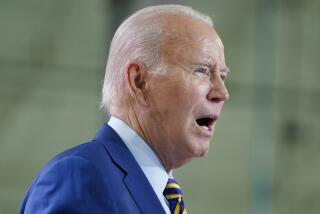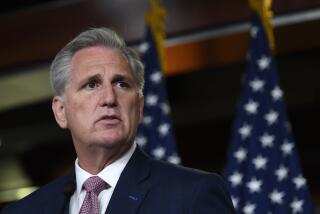Obama lays out goals on healthcare
Reporting from Washington ‚ÄĒ In an 11th-hour bid to rally Democrats behind a sweeping healthcare overhaul, President Obama offered his own detailed plan Monday that would expand coverage, tighten regulation of the insurance industry and seek greater efficiencies in the nation‚Äôs medical system.
FOR THE RECORD:
Healthcare plan: An article in Tuesday‚Äôs Section A about President Obama‚Äôs healthcare plan quoted Democratic strategist Paul Begala as saying, ‚ÄúThe Republican leadership is more likely to perform in a gay marriage than they are to work with Democrats on healthcare.‚ÄĚ The quote should have read, ‚ÄúThe Republican leadership is more likely to perform a gay marriage than they are to work with Democrats on healthcare.‚ÄĚ ‚ÄĒ
The 10-year $950-billion blueprint -- released by the White House three days before a healthcare summit with congressional Democrats and Republicans -- would also raise a variety of taxes and cut Medicare spending while reducing the federal deficit by $100 billion.
In unveiling the plan, the White House also challenged GOP leaders to offer an alternative. But with Republicans firmly against any major healthcare legislation, the president’s primary task is unifying House and Senate Democrats.
After Democrats recently lost their filibuster-proof majority in the Senate, Democratic leaders and the White House hope the House will approve the bill that has already passed the Senate -- along with separate legislation incorporating changes suggested by Obama on Monday to address concerns by House Democrats.
‚ÄúThe real goal here has to be to resolve differences among Democrats,‚ÄĚ said veteran Democratic strategist Paul Begala. ‚ÄúThe Republican leadership is more likely to perform a gay marriage than they are to work with Democrats on healthcare.‚ÄĚ
GOP leaders swiftly condemned the president‚Äôs latest proposal, which House Minority Leader John A. Boehner (R-Ohio) called a ‚Äúnew Democrats-only backroom deal‚ÄĚ that ‚Äúdoubles down on the same failed approach.‚ÄĚ
Republicans have called on Obama to scrap the current bill and pursue more limited legislation.
House Speaker Nancy Pelosi (D-San Francisco) met with rank-and-file House Democrats on Monday evening to discuss the president’s proposal.
Among other issues, she faces the challenge of winning over representatives who want tighter restrictions on abortion funding than those in the Senate bill.
Senate Democrats are slated to discuss healthcare when they meet for their weekly luncheon Tuesday.
White House officials and Democratic congressional leaders have been working on the two-stage strategy in which the House would vote on the Senate bill and both chambers would separately pass a package of changes.
The package could also include traditional Republican healthcare priorities, including new efforts to clamp down on waste and fraud in government healthcare programs.
The extent to which GOP ideas are incorporated could depend on the outcome of Thursday’s summit.
Even without GOP support, Democrats believe that the package could be advanced through a process known as budget reconciliation, which requires only 51 votes in the Senate, rather than the 60-vote supermajority necessary to squash a filibuster.
White House communications director Dan Pfeiffer said Monday that no decision had been made about using budget reconciliation. But he said the president’s proposal was developed with that option in mind.
‚ÄúThe president expects, and believes the American people deserve, an up or down vote on health reform,‚ÄĚ Pfeiffer said. ‚ÄúThe package is designed to provide us the flexibility to achieve that if the Republican party decides to filibuster health reform.‚ÄĚ
Both parties have used budget reconciliation over the last 25 years to advance major domestic initiatives, including the 1996 overhaul of the nation’s welfare system and the major tax cuts enacted by the Bush administration in 2001 and 2003. But it remains controversial, even with some Democrats.
Like the Senate bill, the centerpiece of the president’s plan to expand coverage are new state insurance exchanges in which people who do not get coverage through work would be able to shop for plans. The federal government would oversee the plans, as it now does for members of Congress and other federal employees.
Additionally, the president would give the federal government new authority to regulate premiums charged by private insurers, a new proposal that the White House unveiled over the weekend in response to steep rate hikes in California and elsewhere in recent months.
Under Obama’s proposal, the secretary of Health and Human Services would be able to block premium hikes deemed excessive under standards to be developed by a panel of experts.
That idea drew fire Monday from insurance industry officials, who said rate hikes nationally are being driven primarily by rising medical costs.
‚ÄúRegulating premiums won‚Äôt do anything to reduce the soaring costs of medical care,‚ÄĚ said Karen Ignagni, president of America‚Äôs Health Insurance Plans, the industry‚Äôs Washington-based lobbying arm. ‚ÄúThis would be like capping the prices automakers can charge consumers, but letting the steel, rubber and technology manufacturers charge the automakers whatever they want.‚ÄĚ
Following the Senate‚Äôs lead, the president did not include a new government insurance plan, or ‚Äúpublic option,‚ÄĚ reflecting the idea‚Äôs political delicacy.
Obama’s plan also makes several other substantial changes to the Senate legislation, paralleling agreements hammered out by House and Senate Democratic leaders last month.
It would boost subsidies to help low- and moderate-income people buy insurance on the new state exchanges, a key demand of House Democrats. (The plan does include a national exchange as some House Democrats had wanted.)
Over the next decade, it would phase out the coverage gap in Medicare‚Äôs drug benefit, known as the ‚Äúdoughnut hole.‚ÄĚ
It would provide additional federal aid to states to help them expand their Medicaid insurance programs for the poor and eliminate a provision in the Senate bill that provided special assistance to Nebraska in response to demands from that state’s Democratic senator, Ben Nelson.
The president‚Äôs plan would also scale back a tax on high-end ‚ÄúCadillac‚ÄĚ health plans that is a cornerstone of the Senate‚Äôs healthcare bill.
Under the president’s proposal, the tax would be imposed in 2018 -- rather than 2013 -- and would apply to individual plans worth more than $10,200 and family plans worth more than $27,500, up from $8,500 and $23,000, respectively, in the original bill.
The new subsidies and aid to seniors push up the cost of the bill above the $900-billion threshold identified by the president last year, although the bill still would reduce the deficit over the next decade, administration officials said.
To offset the new costs and lost revenue, the president has proposed increasing the Medicare payroll tax to 2.35% on individuals earning more than $200,000 a year and couples earning more than $250,000.
And he would impose a new 2.9% Medicare tax on unearned income for these high-income taxpayers.
Obama also is proposing an additional $10 billion in taxes on drug makers to help close the doughnut hole, up from the $23 billion in the Senate bill.
More to Read
Get the L.A. Times Politics newsletter
Deeply reported insights into legislation, politics and policy from Sacramento, Washington and beyond. In your inbox three times per week.
You may occasionally receive promotional content from the Los Angeles Times.











